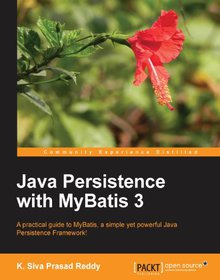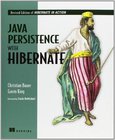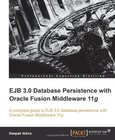Java Persistence with MyBatis 3

Book Details:
| Publisher: | Packt Publishing |
| Series: | Packt |
| Author: | K. Siva Prasad Reddy |
| Edition: | 1 |
| ISBN-10: | 1782166807 |
| ISBN-13: | 9781782166801 |
| Pages: | 132 |
| Published: | Jun 20 2013 |
| Posted: | Nov 19 2014 |
| Language: | English |
| Book format: | |
| Book size: | 3.18 MB |
Book Description:
A practical guide to MyBatis, a simple yet powerful Java Persistence Framework! Overview Detailed instructions on how to use MyBatis with XML and Annotation-based SQL Mappers An in-depth discussion on how to map complex SQL query results such as One-To-Many and Many-To-Many using MyBatis ResultMaps Step-by-step instructions on how to integrate MyBatis with a Spring framework In Detail Storing and retrieving data to and from relational databases is a very common requirement, and is a crucial part of many applications. Even though Java provides a JDBC API for database access, it is not very effective and involves writing the boilerplate code again and again. Getting data out of a database, populating into Java objects, and persisting data from Java objects into a database using JDBC involves a lot of repetitive coding and is a very tedious process. MyBatis takes the simplest approach of leveraging the existing knowledge and power of Java and SQL yet provides powerful features to make data persistence implementation easy. Java Persistence with MyBatis 3 is a practical, hands-on guide that provides you with a number of clear step-by-step exercises, which will help you to understand how MyBatis works and how to use it for your real application needs. With MyBatis, you will learn how to use the MyBatis framework effectively through simple instructions. Java Persistence with MyBatis 3 will highlight the cumbersome process of data persistence using plain JDBC and will also show you how easy it is to implement the same using MyBatis. You will also take a deeper look into the implementation of MyBatis with XML and Annotation-based Mappers, and finally learn how to integrate MyBatis with a Spring framework. You will learn how to map Complex SQL query results to Java beans using XML and Annotation-based Mappers, including One-To-Many and Many-To-Many relationships. You will also learn how to use TypeAliases and Custom Type Handlers, and build dynamic queries using XML and SqlProvider annotations. It progresses to detailed instructions on integrating MyBatis with Spring and leveraging Springs Annotation-based transaction handling mechanism, which further simplifies the usage of MyBatis.With Java Persistence with MyBatis 3, you will learn how to use the MyBatis framework effectively through simple instructions. What you will learn from this book Simplify database persistence layer implementation Install and configure MyBatis using XML and Java API Map One-To-Many and Many-To-Many results using XML and Annotated Mappers Use TypeAliases and Custom Type Handlers Handle pagination and custom SQL ResultSet processing Build Dynamic Queries using XML and SqlProvider annotations Use Springs Annotation-based Transaction Handling with MyBatis Approach This book will have a practical approach, thus making it easy for the readers to understand and learn with step-by-step instructions. Who this book is written for This book is for Java developers who would like to learn all about the MyBatis framework and are looking for a practical guide to get started. The prerequisites required for this book are basic Java and SQL skills. No prior knowledge of MyBatis is expected.
Download Link:
Related Books:
Java Persistence with Hibernate
Persistence-the ability of data to outlive an instance of a program-is central to modern applications. Hibernate, the most popular Java persistence tool, provides automatic and transparent object/relational mapping making it a snap to work with SQL databases in Java applications. Hibernate applications are cheaper, more portable, and more resilient to change. Because it conforms to the new EJB 3.0 and Java Persistence 1.0 standard, Hibernate allows the developer to seamlessly create efficient, scalable Java EE applications. Java Persistence with Hibernate explores Hibernate by developing an application that ties together hundreds of individual examples. You'll immediately dig into the rich programming model of Hibernate 3.2 and Java Persistence, work...
Pro EJB 3
Java Persistence API
EJB 3.0 sets a precedent. It has made huge advances in ease of development, and its drastically simplified programming model has been widely acclaimed. Mike Keith, EJB 3.0 co-specification lead, and Merrick Schinariol, reviewer of EJB 3.0, offer unparalleled insight and expertise on the EJB 3.0 persistence specification, in this definitive guide to EJB 3.0 persistence technology. Expect full coverage and examination of the EJB 3.0 spec from these expert authors, including: The EntityManager API The new features of EJB Query Language (EJB QL) Basic and advanced object-relational mapping Advanced topics like concurrency, locking, inheritance, and polymorphism Assuming a basic knowledge of Java, SQL, JDBC, and some J2EE experience, Keith and Schin...
EJB 3.0 Database Persistence with Oracle Fusion Middleware 11g
This is a practical, tutorial-style book that includes many examples that demonstrate how to develop EJB 3.0 database persistence applications with Oracle Fusion Middleware 11g. Every chapter starts with setting the environment for the chapter and includes an example application illustrated with figures at milestone stages. This book is aimed at EJB 3.0 application developers who want to learn about the practical use of EJB 3.0 database persistence with Oracle Fusion Middleware. Those who are already using EJB 3.0 database persistence will learn about using EJB 3.0 database persistence with Oracle Fusion Middleware 11g. The target audience is expected to have some prior knowledge about Java EE, EJBs, EJB 3.0, JSF, AJAX, web services, and XML. This bo...
2007 - 2021 © eBooks-IT.org



